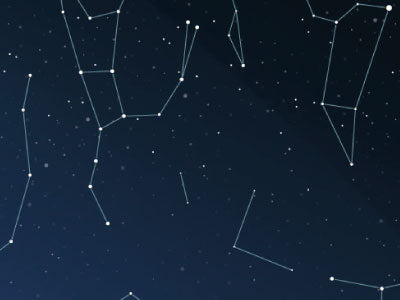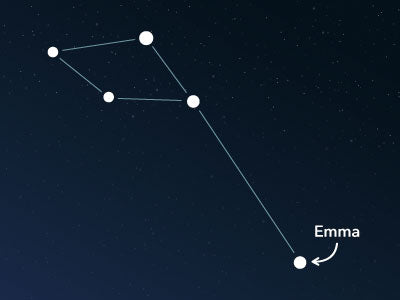The constellation Delphinus
Characteristics
- Other names / Symbolism
- Dolphin
- Hemisphere
- Northern hemisphere
- Visibility
- March - January
- Area
- 189 deg²
- Brightest star
- Rotanev (HIP number 101769)
- Specialties
- Globular clusters, planetary nebulae

The Delphinus, Latin for dolphin, is one of the 48 classical constellations of antiquity named by the Greco-Roman astronomer Claudius Ptolemy. It is one of the smallest constellations in the night sky, yet still very prominent. In the area lie a couple of exciting deep-sky objects.
Hemisphere, visibility, and area
The Delphinus constellation lies in the northern sky near the celestial equator. As a result, it is visible nearly everywhere. It can be observed from all regions in the northern hemisphere. South of the equator, it is visible up to latitude 70. Therefore, it can be seen until the southern polar circle and a little beyond. Only in Antarctica is it not showing.
The constellation can be observed nearly all year round, as it is visible in the night sky from March to January. Different months are optimal for observation, depending on the region. In Central Europe, Canada, and the US, especially the summer months are suitable.
Delphinus is located slightly below the Summer Triangle, which consists of stars from the constellations Cygnus, Lyra, and Aquila.
In the vicinity are also the constellations Vulpecula and Sagitta in the north. To the northwest is Aquila, while Aquarius and Equuleus are to the south. Pegasus borders the constellation in the east.
Although it only covers an area of about 189 square degrees, it is easily identifiable in the night sky due to its distinctive shape. The visualization of the constellation consists of four stars arranged in a diamond shape, which form a trail of stars behind them. The diamond or rhombus represents the body of the jumping dolphin, while the star trail pointing downward represents the tail.
The two brightest stars of Delphinus are named Rotanev (Latin: β Delphini, Beta Delphini) and Sualocin (Latin: α Delphini, Alpha Delphini). Their names have a peculiar feature, as they spell "Nicolaus Venator" when read backward. That is the Latin form of the Italian astronomer Niccolò Cacciatore, who introduced the names to the star catalog in 1814.
Specialties in the constellation
Within the Delphinus constellation are two small globular clusters, NGC 6934 and NGC 7006.
While NGC 6934 is about 50,000 light-years away from earth and can be seen with a small telescope starting at 3 inches, the second globular cluster, NGC 7006, requires a telescope of at least 8 inches in size. This is because this cluster is located at a distance of over 135,000 light-years, making it one of the most distant globular clusters in the Milky Way.
In addition, there are two planetary nebulae within the constellation. NGC 6905, also known as the Blue Flash Nebula, is one of them. It was discovered by the German-British astronomer William Herschel in September 1784 and is located around 3,000 light-years away from earth.
The other planetary nebula has the catalog number NGC 6891. It was discovered by the Scottish astronomer Ralph Copeland in September 1884. On images captured by the Hubble Space Telescope, it appears as a bluish nebula spot.

Mythology
There are two different versions of the origin of the Delphinus constellation. Both refer to Greek mythology.
The first story is about the sea god Poseidon, who fell in love with Amphitrite, a daughter of the Titan Nereus. While Amphitrite's appearance enchanted Poseidon, she did not reciprocate his feelings and fled to her sisters.
In desperation, Poseidon sent messengers to Amphitrite to try and convince her to become his wife. Among them was a dolphin, who won Amphitrite's trust with his charm and persuaded her to become Poseidon's wife.
In gratitude, Poseidon placed the dolphin in the night sky as a constellation.
The second interpretation is about the famous musician Arion, who traveled the world giving concerts and carrying a lot of money with him.
When the sailors of his ship found out about this, they wanted to rob him and throw him overboard. However, they allowed him to sing a last song before his supposed death. His singing attracted dolphins, safely bringing him to the shore, where he could get the sailors to justice.
To commemorate this event, a dolphin was placed in the sky.
Constellation Visibility Tool
Los Angeles, USA
34.05°, -118.24°
Constellation Observing Guide
This guide shows when the constellation is visible above the horizon and provides the optimal viewing window when the sky is darkest. Times are displayed in the location's timezone (PDT).
🎯 Best Observing Window
Optimal time when the constellation is fully visible AND the sky is at its darkest. Perfect for telescopic observations, astrophotography, and viewing faint details.
Optimal start
21:57
Jun 4, 21:57
Optimal end
04:39
Jun 5, 04:39
Duration
6.69h
Prime observing time
✨ Perfect Observing Conditions
This is the overlap when the constellation is above horizon AND the sky is at its darkest. Ideal for telescopic observations and photography.
Constellation Visibility from Your Location
4
Visible Stars
0
Never Rise
0
Always Up
100%
Visible
All stars of this constellation can be observed from your location
Constellation Visibility
When the constellation is above the horizon (includes daylight hours)
Rises
21:50
Jun 4
Fully Up
21:57 – 11:03
Jun 4
Starts Setting
11:03
Jun 5
Fully Set
11:31
Jun 5
Above Horizon Times
Includes daylight hours when stars aren't visible to naked eye.
Astronomical Night
When the sky is darkest (sun >18° below horizon)
Dark sky begins
21:09
Jun 4
Dark sky ends
04:39
Jun 5
Darkest Sky Period
Sun more than 18° below horizon. Best for faint objects.
Observing Tips
Read more interesting articles

An overview of all 88 constellations
Learn more about all 88 constellations and read interesting information about the mythology, visibility, and features.

Planetarium App
Discover the night sky with our planetarium app!
Available for iOS and Android.

Name a star in the constellation Delphinus
Name a star in a constellation and create something that lasts for eternity.